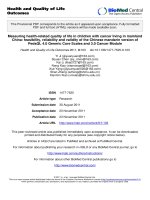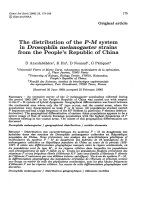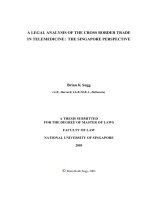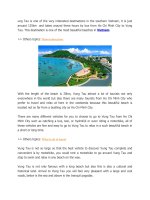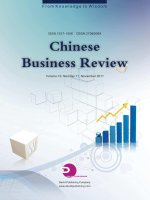ASEAN china FTA 2010 2nd amendment of the agreement on trade in goods
Bạn đang xem bản rút gọn của tài liệu. Xem và tải ngay bản đầy đủ của tài liệu tại đây (389.05 KB, 21 trang )
ASEAN China Free Trade Agreement
2010 2nd Amendment of the Agreement on Trade
in Goods
Completed on October 29, 2010
This document was downloaded from ASEAN Briefing (www.aseanbriefing.com) and was compiled by
the tax experts at Dezan Shira & Associates (www.dezshira.com).
Dezan Shira & Associates is a specialist foreign direct investment practice, providing corporate
establishment, business advisory, tax advisory and compliance, accounting, payroll, due diligence and
financial review services to multinationals investing in emerging Asia.
Appendix 1
ATTACHMENT A
REVISED OPERATIONAL CERTIFICATION PROCEDURES (OCP) FOR
THE RULES OF ORIGIN OF THE ASEAN-CHINA FREE TRADE AREA
For the purpose of implementing the Rules of Origin for the ASEAN-China Free
Trade Area (ACFTA), the following operational procedures on the issuance and
verification of the Certificate of Origin (Form E) and other related administrative
matters shall be followed:
DEFINITIONS
Rule 1
For the purposes of this Attachment:
‘Movement Certificate’ means a Certificate of Origin (Form E) issued by an
intermediate exporting Party, based on the original Certificate of Origin (Form E)
issued by the first exporting Party proving the origin status of the products in
question;
‘Customs Authority’ means the competent authority that is responsible under the
law of a Party for the administration of customs laws and regulations1;
‘Exporter’ means a natural or juridical person located in the territory of a Party
from where a product is exported by such a person;
‘Importer’ means a natural or juridical person located in the territory of a Party
into where a product is imported by such a person;
‘Issuing Authorities’ means any government authority or other entity authorized
under the domestic laws, regulations and administrative rules of a Party to issue
a Certificate of Origin (Form E).
1
Such laws and regulations administered and enforced by the Customs Authority of each Party concerning
importation, exportation and transit of products as they relate to customs duties, charges or other taxes or
prohibitions, restrictions and controls with respect to the movement of controlled items across the boundary
of the Customs Authority of each Party.
1
ISSUING AUTHORITIES
Rule 2
The Certificate of Origin (Form E) shall be issued by the Issuing Authorities of the
exporting Party.
Rule 3
(a)
A Party shall inform all the other Parties of the names and addresses of its
respective Issuing Authorities and shall provide specimen signatures and
specimen of official seals, and correction stamps, if any, used by its Issuing
Authorities.
(b)
The above information and specimens shall be provided to all the other
Parties to the Agreement and a copy furnished to the ASEAN Secretariat. A
Party shall promptly inform all the other Parties of any changes in names,
addresses, or official seals in the same manner.
Rule 4
For the purpose of verifying the conditions for preferential treatment, the Issuing
Authorities shall have the right to call for any supporting documentary evidence
or to carry out any checks considered appropriate. If such right cannot be
obtained through the existing domestic laws, regulations and administrative rules,
it shall be inserted as a clause in the application form referred to in Rules 5 and
6.
APPLICATIONS
Rule 5
(a)
The exporter and/or the manufacturer of the products qualified for
preferential treatment shall apply in writing to the Issuing Authorities requesting
for the pre-exportation verification of the origin of the products. The result of the
verification, subject to review periodically or whenever appropriate, shall be
accepted as the supporting evidence in verifying the origin of the said products to
be exported thereafter. The pre-verification may not apply to the products of
which, by their nature, origin can be easily verified.
(b)
For locally-procured materials, self-declaration by the final manufacturer
exporting under the ACFTA shall be used as the basis when applying for the
issuance of the Certificate of Origin (Form E).
2
Rule 6
At the time of carrying out the formalities for exporting the products under
preferential treatment, the exporter or his authorised representative shall submit
a written application for the Certificate of Origin (Form E) together with
appropriate supporting documents proving that the products to be exported
qualify for the issuance of a Certificate of Origin (Form E).
PRE-EXPORTATION EXAMINATION
Rule 7
The Issuing Authorities shall, to the best of their competence and ability, carry
out proper examination of each application for the Certificate of Origin (Form E)
to ensure that:
(a)
The application and the Certificate of Origin (Form E) are duly completed
in accordance with the requirements as defined in the overleaf notes of the
Certificate of Origin (Form E), and signed by the authorised signatory;
(b)
The origin of the product is in conformity with the Rules of Origin for the
ACFTA;
(c)
The other statements of the Certificate of Origin (Form E) correspond to
supporting documentary evidence submitted;
(d)
Description, quantity and weight of products, marks and number of
packages, number and kinds of packages, as specified, conform to the products
to be exported;
(e)
Multiple items declared on the same Certificate of Origin (Form E) shall be
allowed subject to the domestic laws, regulations and administrative rules of the
importing Party provided each item must qualify separately in its own right2.
ISSUANCE OF CERTIFICATE OF ORIGIN (FORM E)
Rule 8
(a)
The Certificate of Origin (Form E) must be in ISO A4 size paper in
conformity to the specimen as shown in Attachment C. It shall be made in
English.
2
For the purposes of Rule 7(e), the number of multiple items declared on each Certificate of Origin (Form
E) shall not exceed twenty (20) items.
3
(b)
The Certificate of Origin (Form E) shall comprise one original and two (2)
carbon copies of the following colours:
Original DuplicateTriplicate-
Beige (Pantone color code: 727c)
Light Green (Pantone color code: 622c)
Light Green (Pantone color code: 622c)
(c)
Each Certificate of Origin (Form E) shall bear a reference number
separately given by each place of office of issuance.
(d)
The original copy of the Certificate of Origin (Form E) shall be forwarded
by the exporter to the importer for submission to the Customs Authority at the
port or place of importation. The duplicate copy shall be retained by the Issuing
Authorities in the exporting Party. The triplicate copy shall be retained by the
exporter.
(e)
In cases when a Certificate of Origin (Form E) is rejected by the Customs
Authority of the importing Party, the subject Certificate of Origin (Form E) shall be
marked accordingly in Box 4.
(f)
In cases where a Certificate of Origin (Form E) is not accepted, as stated
in paragraph (e), the Customs Authority of the importing Party shall consider the
clarifications made by the Issuing Authorities and assess whether or not the
Certificate of Origin (Form E) can be accepted for the granting of the preferential
treatment. The clarification shall be detailed and exhaustive in addressing the
grounds for denial of preferential treatment raised by the importing Party.
Rule 9
To implement the provisions of Rule 2 of the Rules of Origin for the ACFTA, the
Certificate of Origin (Form E) issued by the final exporting Party shall indicate the
origin criteria or applicable percentage of ACFTA value content in Box 8.
Rule 10
Neither erasures nor superimposition shall be allowed on the Certificate of Origin
(Form E). Any alteration shall be made by striking out the erroneous materials
and making any addition required. Such alterations shall be approved by an
official authorised to sign the Certificate of Origin (Form E) and certified with
official seals or correction stamps of the Issuing Authorities. Unused spaces shall
be crossed out to prevent any subsequent addition.
4
Rule 11
In principle, a Certificate of Origin (Form E) shall be issued prior to or at the time
of shipment. In exceptional cases where the Certificate of Origin (Form E) has
not been issued by the time of shipment or no later than three (3) days from the
date of shipment, at the request of the exporter, the Certificate of Origin (Form E)
shall be issued retroactively in accordance with the domestic laws, regulations
and administrative rules of the exporting Party within twelve (12) months from the
date of shipment, in which case it is necessary to indicate “ISSUED
RETROACTIVELY” in Box 13. In such cases, the importer of the product who
claims the preferential treatment for the product may, subject to the domestic
laws, regulations administrative rules of the importing Party, provide the Customs
Authority of the importing Party with the Certificate of Origin (Form E) issued
retroactively.
Rule 12
(a)
The Issuing Authorities of the intermediate Party within the ACFTA may
issue a Movement Certificate (MC), if an application is made by the exporter
while the product is passing through the territory, provided that:
(i)
the importer of the intermediate Party and the exporter who applies
for the MC in the intermediate Party are the same;
(ii)
a valid original Certificate of Origin (Form E) issued by the first
exporting Party is presented;
(iii)
information on the MC includes the names of the Issuing Authorities
of the Party which issued the original Certificate of Origin (Form E),
date of issuance and reference number. The FOB value shall be
the FOB value of the products exported from the intermediate
Party; and
(iv)
the total quantity of the products covered in the MC does not
exceed the total quantity of the products covered in the original
Certificate of Origin (Form E).
(b)
In the case of China, the MC shall be issued by Customs Authority. In the
case of ASEAN Member States, the MC shall be issued by the Issuing
Authorities.
(c)
The validity of the MC shall have the same end-date as the original
Certificate of Origin (Form E).
5
(d)
The product which is to be re-exported using MC shall be under control of
the Customs Authority of the intermediate Party. The products shall not undergo
any further processing in the intermediate Party, except for repacking and
logistics activities consistent with Rule 8 of the Rules of Origin for the ACFTA3.
(e)
The verification procedure in Rule 18 shall also apply to the MC. In
particular, the Customs Authority of the importing Party may request
simultaneously the original exporting Party and the intermediate Party to provide
information regarding the original Certificate of Origin (Form E) and the MC
respectively, such as the first exporter, last exporter, reference number,
description of the products, country of origin and the port of discharge, within
thirty (30) days from the date of receipt of the request as the case maybe.
Rule 13
In the event of theft, loss or destruction of a Certificate of Origin (Form E), the
exporter may apply in writing to the Issuing Authorities which issued it for the
certified true copy of the original and the triplicate to be made on the basis of the
export documents in their possession bearing the endorsement of the words
“CERTIFIED TRUE COPY” in Box 12. This copy shall bear the date of the
original Certificate of Origin (Form E). The certified true copy of a Certificate of
Origin (Form E) shall be issued no later than one (1) year from the date of
issuance of the original Certificate of Origin (Form E) and on condition that the
exporter provides to the relevant Issuing Authorities the triplicate copy or any
proof on the issuance of the original Certificate of Origin (Form E).
PRESENTATION
Rule 14
The original copy of the Certificate of Origin (Form E) shall be submitted to the
Customs Authority at the time of lodging the import entry for the products
concerned claiming for preferential treatment in accordance with the domestic
laws, regulations and administrative rules of the importing Party.
Rule 15
The Certificate of Origin (Form E) shall remain valid and must be submitted to the
Customs Authority of the importing Party within one (1) year from the date of its
issuance by the Issuing Authority of the exporting Party.
3
The products under control of the Customs Authority of the intermediate Party shall include products that
remain in free trade zones or locations approved by the said Customs Authority.
6
Rule 16
In the case of consignments of products originating in the exporting Party and not
exceeding US$ 200.00 FOB, the production of a Certificate of Origin (Form E)
shall be waived and the use of simplified declaration by the exporter that the
products in question have originated in the exporting Party shall be accepted.
Products sent through the post not exceeding US$200.00 FOB shall also be
similarly treated.
Rule 17
(a)
Where the ACFTA origin of the product is not in doubt, unsubstantial
discrepancies, such as tariff classification differences between the statements
made in the Certificate of Origin (Form E) and those made in the documents
submitted to the Customs Authority of the importing Party for the purpose of
carrying out the formalities for importing the products shall not ipso-facto
invalidate the Certificate of Origin (Form E), if it does in fact correspond to the
products submitted.
(b)
In cases where the exporting Party and importing Party have unsubstantial
discrepancies as indicated in paragraph (a), the products shall be released
without any delay and subject to administrative measures, such as imposition of
customs duties at the higher applied rate or its equivalent amount of deposit.
Once the discrepancies have been resolved, the correct ACFTA rate is to be
applied and any overpaid duty shall be refunded, in accordance with the
domestic laws, regulations and administrative rules of the importing Party.
(c)
For multiple items declared under the same Certificate of Origin (Form E),
a problem encountered with one of the items listed shall not affect or delay the
granting of preferential treatment and customs clearance of the remaining items
listed in the Certificate of Origin (Form E). Rule 18(a)(ii) may be applied to the
problematic items.
Rule 18
(a)
The Customs Authority of the importing Party may request a retroactive
check at random and/or when it has reasonable doubt as to the authenticity of
the document or as to the accuracy of the information regarding the true origin of
the products in question or of certain parts thereof.
(i)
The request shall be made in writing, accompanied with a copy of
the Certificate of Origin (Form E) and shall specify the reasons and
any additional information suggesting that the particulars given on
the said Certificate of Origin (Form E) may be inaccurate, unless
the retroactive check is requested on a random basis.
7
(ii)
The Customs Authority of the importing Party may suspend the
granting of preferential treatment while awaiting the result of
verification. However, it may release the products to the importer
subject to any administrative measures deemed necessary,
including imposition of customs duties at the higher applied rate or
equivalent amount of deposit, provided that they are not held to be
subject to import prohibition or restriction and there is no suspicion
of fraud.
(iii)
The Customs Authority or the Issuing Authorities of the exporting
Party receiving a request for retroactive check shall respond to the
request promptly and reply not later than ninety (90) days after the
receipt of the request.
(b) If the Customs Authority of the importing Party is not satisfied with the
outcome of the retroactive check, it may, under exceptional cases, request for
verification visits to the exporting Party.
(i)
Prior to the conduct of a verification visit pursuant to the provisions
herein, the Customs Authority of the importing Party shall notify the
competent authority of the exporting Party with an aim to mutually
agree on the conditions and means of the verification visit.
(ii)
The verification visit shall be conducted not later than sixty (60)
days after receipt of the notification pursuant to sub-paragraph
(b)(i).
(c) The verification process, including the retroactive check and verification visit,
shall be carried out and its results communicated to the Customs Authority
and/or the Issuing Authorities of the exporting Party within a maximum of one
hundred and eighty (180) days. While awaiting the results of the verification visit,
sub-paragraph (a)(ii) on the suspension of preferential treatment shall be
applied.
(d) The preferential treatment may be denied when the exporting Party fails to
respond to the request to the satisfaction of the Customs Authority of the
importing Party in the course of a retroactive check or verification process, as the
case may be, within the time frame for verification under paragraphs (a), (b) and
(c).
(e) Each Party shall maintain the confidentiality of the information and
documents provided by the other Party in the course of verification process. Such
information and documents shall not be used for other purposes, including being
used as evidence in administrative and judicial proceedings, without the explicit
written permission of the Party providing such information.
8
RECORD KEEPING REQUIREMENT
Rule 19
(a)
The application for the Certificate of Origin (Form E) and all documents
related to such application shall be retained by the Issuing Authorities for not less
than three (3) years from the date of issuance.
(b)
Information relating to the validity of the Certificate of Origin (Form E) shall
be furnished upon request by the importing Party.
(c)
Any information communicated between the Parties concerned shall be
treated as confidential and shall be used for the validation of the Certificate of
Origin (Form E) purposes only.
(d)
For the purposes of the verification process/retroactive check pursuant to
Rule 18 the producer and/or exporter applying for the issuance of a Certificate of
Origin (Form E) shall, subject to the domestic laws, regulations and
administrative rules of the exporting Party, keep its supporting records for
application for not less than three (3) years from the date of issuance of the
Certificate of Origin (Form E).
SPECIAL CASES
Rule 20
When the destination of the products exported to a specified Party is changed,
before or after their arrival in the Party, the following rules shall be observed:
(a)
If the products have already been submitted to the Customs Authority in
the specified importing Party, the Certificate of Origin (Form E) shall, by a written
application of the importer, be endorsed to address the situation. The original
shall be kept by the Customs Authority and the photocopy of the Certificate of
Origin (Form E) shall be provided to the importer.
(b)
If the changing of destination occurs during transportation to the importing
Party as specified in the Certificate of Origin (Form E), the exporter shall apply in
writing, accompanied with the issued Certificate of Origin (Form E), for the new
issuance of the Certificate of Origin (Form E).
9
Rule 21
For the purpose of implementing Rule 8(c) of the Rules of Origin for the ACFTA,
where transportation is effected through the territory of one or more non-ACFTA
Parties, the following shall be submitted to the Customs Authority of the importing
Party:
(a)
A through Bill of Lading issued in the exporting Party;
(b) A Certificate of Origin (Form E) issued by the relevant Issuing Authorities of
the exporting Party;
(c)
A copy of the original commercial invoice in respect of the product; and
(d) Supporting documents in evidence that the requirements of Rule 8(c) subparagraphs (i),(ii) and (iii) of the Rules of Origin for the ACFTA are being
complied with.
Rule 22
(a) Products sent from an exporting Party for exhibition in another Party and sold
during or after the exhibition into a Party shall benefit from the ASEAN-China
preferential treatment on the condition that the products meet the requirements of
the Rules of Origin for the ACFTA provided it is shown to the satisfaction of the
Customs Authority of the importing Party that:
(i)
an exporter has dispatched those products from the territory of the
exporting Party to another Party where the exhibition is held and
has exhibited them there;
(ii)
the exporter has sold the products or transferred them to a
consignee in the importing Party; and
(iii)
the products have been consigned during the exhibition or
immediately thereafter to the importing Party in the state in which
they were sent for exhibition.
(b)
For purposes of implementing the above provisions, the Certificate of
Origin (Form E) must be submitted to the Customs Authority of the importing
Party. The name and address of the exhibition must be indicated, a certificate
issued by the Issuing Authorities of the Party where the exhibition took place
together with supporting documents prescribed in Rule 21(d) may be required.
10
(c)
Paragraph (a) shall apply to any trade, agricultural or crafts exhibition, fair
or similar show or display in shops or business premises with the view to the sale
of foreign products and where the products remain under customs control during
the exhibition.
Rule 23
The Customs Authority of the importing Party shall accept a Certificate of Origin
(Form E) in cases where the sales invoice is issued either by a company located
in a third country or by an ACFTA exporter for the account of the said company,
provided that the product meets the requirements of the Rules of Origin for the
ACFTA. The third party invoice number should be indicated in Box 10 of the
Certificate of Origin (Form E), the exporter and consignee must be located in the
Parties and the copy of the third party invoice shall be attached to the Certificate
of Origin (Form E) when presenting to the Customs Authority of the importing
Party.
ACTION AGAINST FRAUDULENT ACTS
Rule 24
(a)
When it is suspected that fraudulent acts in connection with the Certificate
of Origin (Form E) have been committed, the Government authorities concerned
shall co-operate in the action to be taken in the territory of the respective Party
against the persons involved.
(b)
Each Party shall be responsible for providing legal sanctions for fraudulent
acts related to the Certificate of Origin (Form E) in accordance with its domestic
laws, regulations and administrative rules.
Rule 25
In the case of a dispute concerning origin determination, classification or
products or other matters, the Government authorities concerned in the importing
and exporting Parties shall consult each other with a view to resolving the
dispute, and the result shall be reported to the other Parties for information.
11
Original (Duplicate/Triplicate)
Reference No.
1. Products consigned from (Exporter's business name,
ASEAN-CHINA FREE TRADE AREA
address, country)
PREFERENTIAL TARIFF
CERTIFICATE OF ORIGIN
(Combined Declaration and Certificate)
2. Products consigned to (Consignee's name, address,
FORM E
country)
Issued in ______________
(Country)
See Overleaf Notes
3. Means of transport and route (as far as known)
4. For Official Use
Departure date
Preferential Treatment Given
Vessel's name/Aircraft etc.
Preferential Treatment Not Given (Please
state reason/s)
Port of Discharge
..................................................................................
Signature of Authorised Signatory of the Importing
Party
5. Item
number
6. Marks and
numbers on
packages
7. Number and type of
packages, description of
products (including quantity
where appropriate and HS
number of the importing
Party)
11. Declaration by the exporter
8. Origin criteria
(see Overleaf
Notes)
9. Gross
weight or
other quantity
and value
(FOB)
10. Number and
date of
invoices
12. Certification
The undersigned hereby declares that the above
details and statement are correct; that all the products
were produced in
It is hereby certified, on the basis of control
carried out, that the declaration by the
exporter is correct.
.............................................................
(Country)
and that they comply with the origin requirements
specified for these products in the Rules of Origin
for the ACFTA for the products exported to
.............................................................
(Importing Country)
.............................................................
Place and date, signature of
authorised signatory
13
□ Issued Retroactively
□ Exhibition
□ Movement Certificate
□ Third Party Invoicing
................................................................................
Place and date, signature and stamp of
certifying authority
OVERLEAF NOTES
1.
Parties which accept this form for the purpose of preferential treatment under the ASEAN-CHINA Free Trade Area Preferential Tariff:
BRUNEI DARUSSALAM
INDONESIA
MYANMAR
THAILAND
2.
3.
CAMBODIA
LAOS
PHILIPPINES
VIETNAM
CHINA
MALAYSIA
SINGAPORE
CONDITIONS: The main conditions for admission to the preferential treatment under the ACFTA Preferential Tariff are that products
sent to any Parties listed above:
(i)
must fall within a description of products eligible for concessions in the country of destination;
(ii)
must comply with the consignment conditions that the products must be consigned directly from any ACFTA Party to the
importing Party but transport that involves passing through one or more intermediate non-ACFTA Parties, is also accepted
provided that any intermediate transit, transshipment or temporary storage arises only for geographic reasons or
transportation requirements; and
(iii)
must comply with the origin criteria given in the next paragraph.
ORIGIN CRITERIA: For exports to the above mentioned countries to be eligible for preferential treatment, the requirement is that
either:
(i)
The products wholly obtained in the exporting Party as defined in Rule 3 of the Rules of Origin for the ACFTA;
(ii)
Subject to sub-paragraph (i) above, for the purpose of implementing the provisions of Rule 2 (b) of the Rules of Origin for the
ACFTA, products worked on and processed as a result of which the total value of the materials, parts or produce originating
from non-ACFTA Parties or of undetermined origin used does not exceed 60% of the FOB value of the product produced or
obtained and the final process of the manufacture is performed within territory of the exporting Party;
(iii)
Products which comply with origin requirements provided for in Rule 2 of the Rules of Origin for the ACFTA and which are
used in a Party as inputs for a finished product eligible for preferential treatment in another Party/Parties shall be considered
as a product originating in the Party where working or processing of the finished product has taken place provided that the
aggregate ACFTA content of the final product is not less than 40%; or
(iv)
Products which satisfy the Product Specific Rules provided for in Attachment B of the Rules of Origin for the ACFTA shall be
considered as products to which sufficient transformation has been carried out in a Party.
If the products qualify under the above criteria, the exporter must indicate in Box 8 of this form the origin criteria on the basis of which
he claims that his products qualify for preferential treatment, in the manner shown in the following table:
Circumstances of production or manufacture in the first country
named in Box 11 of this form
(a)
Products wholly produced in the country of exportation (see
paragraph 3 (i) above)
Insert in Box 8
“WO”
(b)
Products worked upon but not wholly produced in the exporting
Party which were produced in conformity with the provisions of
paragraph 3 (ii) above
Percentage of single country content,
example 40%
(c)
Products worked upon but not wholly produced in the exporting
Party which were produced in conformity with the provisions of
paragraph 3 (iii) above
Percentage of ACFTA cumulative
content, example 40%
(d)
Products satisfied the Product Specific Rules (PSR)
“PSR”
4.
EACH ARTICLE MUST QUALIFY: It should be noted that all the products in a consignment must qualify separately in their own right.
This is of particular relevance when similar articles of different sizes or spare parts are sent.
5.
DESCRIPTION OF PRODUCTS: The description of products must be sufficiently detailed to enable the products to be identified by
the Customs Officers examining them. Name of manufacturer, any trade mark shall also be specified.
6.
The Harmonised System number shall be that of the importing Party.
7.
The term “Exporter” in Box 11 may include the manufacturer or the producer. In the case of MC the term “Exporter” also includes the
exporter in the intermediate Party,
8.
FOR OFFICIAL USE: The Customs Authority of the importing Party must indicate ( 9 ) in the relevant boxes in column 4 whether or
not preferential treatment is accorded
9.
Movement Certificate: In cases of Movement Certificate, in accordance with Rule 12 of the Operational Certification Procedures,
“Movement Certificate” in Box 13 should be ticked (√). The name of original Issuing Authorities of the Party, date of the issuance
and the reference number of the original Certificate of Origin (Form E) to be indicated in Box 13.
10.
THIRD PARTY INVOICING: In cases where invoices are issued by a third country, “the Third Party Invoicing” in Box 13 shall be
ticked (√). The invoice number shall be indicated in Box 10. Information such as name and country of the company issuing the
invoice shall be indicated in Box 7.
11. EXHIBITIONS: In cases where products are sent from the exporting Party for exhibition in another Party and sold during or after
the exhibition for importation into a Party, in accordance with Rule 22 of Attachment A of the Rules of Origin for the ACFTA, the
“Exhibitions” in Box 13 should be ticked (√) and the name and address of the exhibition indicated in Box 2.
12. ISSUED RETROACTIVELY: In exceptional cases, due to involuntary errors or omissions or other valid causes, the Certificate of
Origin (Form E) may be issued retroactively in accordance with Rule 11 of Attachment A of the Rules of Origin for the ACFTA.
The “Issued Retroactively” in Box 13 shall be ticked (√).
